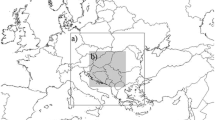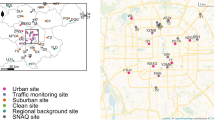Abstract
A short-term forecast of the city “chemical weather” requires real daily data on pollutant emissions. For operational daily forecasts of pollutant concentrations, usually long-term emission averages are used which may differ significantly from real values for a certain day, especially in big cities with intense and variable human activities. The online coupled atmospheric chemical transport model COSMO-ART was implemented for the Moscow region, Russia. A method for calculation of pollutant emissions for short-term forecasting was suggested. In this method, “actual” emissions for a certain day are obtained from measurements of air pollutant concentrations. It is assumed that the pollutant concentration reflects the spatially averaged intensity of emission sources. We used the observational data of pollutant concentrations from the network of the State Ecological Monitoring System of Moscow City. In order to get a more homogeneous field of data, “virtual” stations (so-called "bogus data") were added within the areas not covered with observations. The proposed method allows a transformation of the hourly measurements of air pollutant concentration to emission values just after the measurements are completed. We showed the application of this method for carbon monoxide. Verification of COSMO-ART results demonstrates that the forecasts based on emissions calculated by the new method are better than the ones based on climate mean emissions. The approach suggested in the study provides a possibility to issue more detailed operational short-term forecasts of pollutant concentrations for megacities depending on the real air pollution of the previous day. The main limitation of this methodology is that it can be applied to the chemical species that have longer chemical life-time compared to the frequency of concentration measurements.







Similar content being viewed by others
References
Baklanov, A., Korsholm, U., Mahura, A., Petersen, C., & Gross, A. (2008). ENVIRO-HIRLAM: online coupled modelling of urban meteorology and air pollution. Advances in Science and Research, 2, 41–46.
Baklanov, A. (2010). Chemical weather forecasting: a new concept of integrated modeling. Advances in Science and Research, 4, 23–27.
Baklanov, A., Schlünzen, K., Suppan, P., Baldasano, J., Brunner, D., Aksoyoglu, S., et al. (2014). Online coupled regional meteorology chemistry models in Europe current status and prospects. Atmospheric Chemistry and Physics, 14, 317–398.
Baklanov, A., Smith Korsholm, U., Nuterman, R., Mahura, A., Nielsen, K. P., Sass, B. H., et al. (2017). Enviro-HIRLAM online integrated meteorology–chemistry modelling system: strategy, methodology, developments and applications (v7.2). Geoscientific Model Development, 10, 2971–2999.
Baldauf, M., Seifert, A., Förstner, J., Majewski, D., Raschendorfer, M., & Reinhardt, T. (2011). Operational convective scale numerical weather prediction with the COSMO model: description and sensitivities. Monthly Weather Review, 139, 3887–3905. https://doi.org/10.1175/MWR-D-10-05013.1.
Bangert, M. (2007). Eine parametrisierung fur die berechnung von photolysefrequenzen in chemie-transport-modellen. Institut für Meteorologie und Klimaforschung der Universitat Karlsruhe (TH) Seminararbeit.
Brimblecombe, P. (1996). Air composition and chemistry. Cambridge: Cambridge University Press.
Denier van der Gon, H., Visschedijk, A., van der Brugh, H., Dröge, R. (2010). A high resolution European emission data base for the year 2005. A contribution to UBA- projekt PAREST: particle reduction strategies. TNO-report TNO-034-UT-2010-01895 RPTML.
Fortems-Cheiney, A., Chevallier, F., Pison, I., Bousquet, P., Carouge, C., Clerbaux, C., et al. (2009). On the capability of IASI measurements to inform about CO surface emissions. Atmospheric chemistry and physics, 9, 8735–8743. https://doi.org/10.5194/acp-9-8735-2009.
Gorchakov, G. I., Semutnikova, E. G., Zotkin, E. V., Karpova, A. V., Lezinab, E. A., & Ul’yanenko, A. V. (2006). Variations in gaseous pollutants in the air basin of Moscow. Izvestiya, Atmospheric and Oceanic Physics, 42(2), 156–170.
Grell, G. A., Peckham, S. E., Schmitz, R., McKeen, S. A., Frost, G., Skamarock, W. C., et al. (2005). Fully coupled ‘online’ chemistry in the WRF model. Atmospheric Environment, 39, 6957–6976.
Hooghiemstra, P. B., Krol, M. C., Meirink, J. F., Bergamaschi, P., van der Werf, G. R., Novelli, P. C., et al. (2011). Optimizing global CO emission estimates using a four-dimensional variational data assimilation. Atmospheric chemistry and physics, 11, 4705–4723. https://doi.org/10.5194/acp-11-4705-2011.
Holton, J. R. (2004). An introduction to dynamic meteorology. Burlington: Elsevier Academic Press.
Huijnen, V., Williams, J., van Weele, M., van Noije, T., Krol, M., Dentener, F., et al. (2010). The global chemistry transport model TM5: description and evaluation of the tropospheric chemistry version 3.0, 2010. Geoscientific Model Development, 3, 445–473. https://doi.org/10.5194/gmd-3-445-2010.
Kaminski, J. W., Neary, L., Struzewska, J., McConnell, J. C., Lupu, A., Jarosz, J., et al. (2008). GEM-AQ, an online global multiscale chemical weather modelling system: model description and evaluation of gas phase chemistry processes. Atmospheric Chemistry & Physics, 8, 3255–3281.
Kaminski, J. W., Plummer, D. A., Neary, L., McConnell, J. C., Struzewska, J., & Lobocki, L. (2002). First application of MC2-AQ to multiscale air quality modelling over Europe. Physics and Chemistry of the Earth, 27–35, 1517–1524.
Knote, C., Brunner, D., Vogel, H., Allan, J., Asmi, A., Äijälä, M., et al. (2011). Towards an online-coupled chemistry climate model: evaluation of trace gases and aerosols in COSMO-ART. Geoscientific Model Development, 4, 1077–1102. https://doi.org/10.5194/gmd-4-1077-2011.
Kopacz, M., Jacob, D. J., Fisher, J. A., Logan, J. A., Zhang, L., Megretskaia, I. A., et al. (2010). Global estimates of CO sources with high resolution by adjoint inversion of multiple satellite datasets (MOPITT, AIRS, SCIAMACHY, TES). Atmospheric Chemistry and Physics, 10, 855–876. https://doi.org/10.5194/acp-10-855-2010.
Koohkan, R. M., & Bocquet, M. (2012). Accounting for representativeness errors in the inversion of atmospheric constituent emissions: application to the retrieval of regional carbon monoxide fluxes. Tellus B, 64, 19047.
Kuenen, J., Denier van der Gon, H., Visschedijk, A., van der Brugh, H. (2011). High resolution European emission inventory for the years 2003–2007. TNO-report TNO-060-UT-2011-00588.
Kurbatova, A., Bashkin, V. N., & Kasimov, N. S. (2004). City ecology. Moscow: Scientific World.
Mastroianni, G., Milovanovic, G. (2008). Interpolation processes: basic theory and applications. (pp. 446). Springer Monographs in Mathematics. https://doi.org/10.1007/978-3-540-68349-0.
Mellor, G. L., & Yamada, T. (1974). A hierarchy of turbulence closure models for planetary boundary layers. Journal of the Atmospheric Sciences, 31, 1791–1806.
Mellor, G. L., & Yamada, T. (1982). Development of a turbulence closure model for geophysical flow problems. Reviews of Geophysics and Space Physics, 20, 851–875.
Mircea, M., d’Isidoro, M., Maurizi, A., Vitali, L., Monforti, F., Zanini, G., et al. (2007). A comprehensive performance evaluation of the air quality model BOLCHEM over Italy. Atmos: Env. https://doi.org/10.1016/j.atmosenv.2007.10.043.
Protonotariou, A. P., Kostopoulou, E., Tombrou, M., & Giannakopoulos, Christos. (2013). European CO budget and links with synoptic circulation based on GEOS-CHEM model simulations. Tellus B., 65, 18640. https://doi.org/10.3402/tellusb.v65i0.18640.
Pulles T., van het Bolscher M., Brand R., Visschedijk A. (2007). Assessment of global emissions from fuel combustion in the final decades of the 20th Century. TNO-Report. 2007-A-R0132B.
Revokatova, A. P. (2013). A method of carbon monoxide emission forecast in Moscow. Russian Meteorology and Hydrology, 38(6), 396–404. https://doi.org/10.3103/S1068373913060046.
Saide, P., Osses, A., Gallardo, L., & Osses, M. (2009). Adjoint inverse modeling of a CO emission inventory at the city scale: Santiago de Chile’s case. Atmospheric Chemistry and Physics Discussions, 9, 6325–6361. https://doi.org/10.5194/acpd-9-6325-2009.
Suppan, P., Forkel, R., Haas, E. (2010). The online coupled mesoscale climate–chemistry model MCCM: a modelling tool for short episodes as well as for climate periods. Chapter integrated systems of meso-meteorological and chemical transport models, pp 81–88.
Tangborn, A., Stajner, I., Buchwitz, M., Khlystova, I., Pawson, S., Burrows, J., et al. (2009). Assimilation of SCIAMACHY total column CO observations: global and regional analysis of data impact. Journal of Geophysical Research: Atmospheres, 114, D07307. https://doi.org/10.1029/2008JD010781.
Vilfand, R. M., Rivin, G. S., & Rozinkina, I. A. (2010). Mesoscale weather short-range forecasting at the Hydrometcenter of Russia, on the example of COSMO-RU. Russian Meteorology and Hydrology, 35(1), 1–9.
Vogel, B., Vogel, H., Baumner, D., Bangert, M., Lundgren, K., Rinke, R., et al. (2011). COSMO-ART: aerosols and reactive trace gases within the COSMO model. In A. Baklanov, A. Mahura, & R. S. Sokhi (Eds.), Integrated systems of meso-meteorological and chemical transport models (pp. 75–80). Berlin: Springer.
Vogel, B., Vogel, H., Baumer, D., Bangert, M., Lundgren, K., Rinke, R., et al. (2009). The comprehensive model system COSMO-ART—radiative impact of aerosol on the state of the atmosphere on the regional scale. Atmospheric Chemistry and Physics, 9(22), 8661–8680.
Acknowledgements
We thank the State Ecological Monitoring System of Moscow (Russia) for observations. This work was partially supported by a grant from the Russian Foundation for Basic Research (no. 16-05-00509), partially supported by the Russian Science Foundation under grant no. 16-17-10275 (part of model implementation support). We acknowledge Hugo van der Gon and his colleagues from TNO (Netherlands) for providing the basis emission data set and Dominick Brunner from EMPA (Swiss Federal Laboratories for Materials Science and Technology, Switzerland) who transferred these annual emissions to hourly values on the COSMO-ART grid.
Author information
Authors and Affiliations
Corresponding author
Rights and permissions
About this article
Cite this article
Revokatova, A., Kislov, A., Surkova, G. et al. Short-Term Forecast of the Carbon Monoxide Concentration Over the Moscow Region by COSMO-ART. Pure Appl. Geophys. 176, 885–899 (2019). https://doi.org/10.1007/s00024-018-2001-z
Received:
Revised:
Accepted:
Published:
Issue Date:
DOI: https://doi.org/10.1007/s00024-018-2001-z




